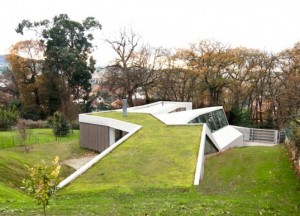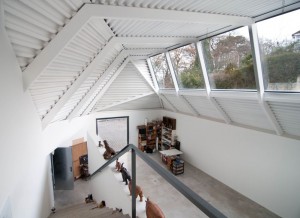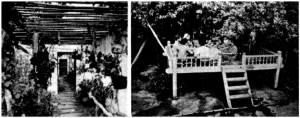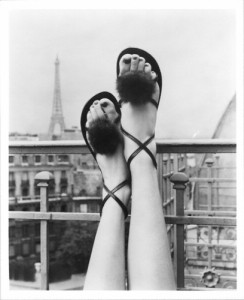STUDIOHOUSE-F451
Critical Analysis:
I did not quite understand why a Home had to merge with an Industrial shed to become a hybrid space for an Artist, but it works.
The form of Studio House F451 exploits an aesthetic: harsh, angular structure rising out of undulating land; the pleasant white colour of the double storeyed building sits against a green terrain backdrop, almost emerging from it. “The simplicity of construction is betrayed by the corrugated metal panels that cover every ceiling: a glimpse of the metal structure that underpins it all” the designer states.
The whole building is designed by positional relationships taking into consideration the existing trees at the site.The use of North light (concept from an Industrial workshop) through angled glass windows allowing even light for an Artist’s studio is an idea which maximises available abundant resource of sunlight while minimising the use of energy for lighting; the double height space creates a volume/room for creativity, although large almost open to nature – floor to ceiling windows; could have been an option to allow nature to come into living spaces, creating a boundless feeling, also connecting landscape with architecture like the designers have attempted to.
Materialisation of the design, Honey comb clay block and landscaped roof are quite interesting which adds to insulation-going green- energy efficiency, however a region specific material or a rustic woody feel in relation to the regional context according to me seems to be missing.
The program/function specificity, with 4 autonomous but interrelated units – house, guest apartment, atelier and garage- together with the slope from the terrain design the frame where they have integrated both types into a single volume is a smart design solution to the space being used as whole or as smaller units and also as a climate regulator. The design also aids cross ventilation along natural lighting, the slopes- roofs of the design aid rain water collection and use.
But could there have been a thought towards energy generation? Could there have been a thought towards Zero-debris? Towards a holistic living?
Over all STUDIOHOUSE F451 is a space which has taken a leap towards green living by merging architecture and landscape.
Bernard Rudofsky : An American writer, Architect, Collector, Teacher, Designer, and Social historian.
Bernard Rudofsky: Conditioned outdoor spaces
In the article Rudofsky starts with identifying the manner in which it was distinctly marked by his encounters with modernity—from the violent wars of the first-half of the twentieth century and the subsequent Cold War period to the rise of information technology and the exacerbated deracination driving the period’s growing territorial insecurity. He continues to speak about the abuse of technology and its effects on human lifestyle correlating it with the environment, attempting to tame nature to man’s conveniences by having ice-skating in hot summers and hot tub in cold winters. Of also architects building windowless factories and offices, of tunnels and underground structures and of humans living in burrows with heaps of waste on the top.
The Author expresses his surprise of why “wall” has never been acknowledged as one of mankind’s greatest inventions, as “wall” initiated the lifestyle shift by taking shelter in a more permanent structure as compared to a tree that changes with season.
Continues to then refer to gardens of the Romans and of Pompeii, of how they were as ornate as the interiors of the buildings were with marbles mosaic etc., of how gardens could be living spaces as compared to being a visual treat as they are today, of gardens being a place to eat sleep and live. Gardens according to him should be a place where a family could enjoy the morning sun having their breakfast or having a siesta time in the afternoon under the shade of a tree or a place to sit and enjoy reading a book. A garden not for the outsiders, but for the inhabitants as a private living space with a wall at the outer edge to take the garden space indoor, as compared to a picket fence.
He interestingly conveys the relationship between nature and architecture, of their co-existence and dependency, of a fine line between the two.
Reading further about the Author,
I was fascinated to know about his study of feet after which he designed women footwear. Architecture without architects, a book where he studies and explains about self-built structures by people with no formal education in architecture.
My area of interest for research would be towards a holistic design approach for social needs and problems addressing a range of issues from diversity and hunger, to homelessness and gun violence, for human-centric barrier free design thinking.
References:
http://inhabitat.com/honeycomb-clay-walls-and-a-green-roof-insulate-hybrid-home-and-atelier-in-spain/
http://inhabitat.com/honeycomb-clay-walls-and-a-green-roof-insulate-hybrid-home-and-atelier-in-spain/
http://www.setimanitoba.org/column/2013/1/22/pattern-163-outdoor-room.html
http://www.getty.edu/art/exhibitions/rudofsky/events.html




